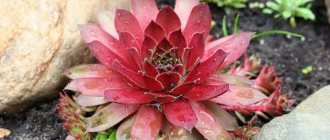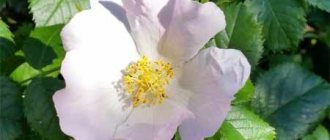Of course, rose is one of the most popular flowers. And not in vain, because everyone likes its delicate appearance and pleasant aroma. Any gardener knows that this plant will perfectly decorate a summer cottage.
However, the climbing rose can cope with this better than all other varieties. How to grow it correctly so that it is lush and luxurious?
Choosing a place for a climbing rose
The climbing rose is very sun-loving, so the place for growing it should be well lit and ventilated; it is better to choose an area with a slight slope.
The rose has long roots, so it is recommended to plant it in elevated places - this will help avoid increased humidity in the roots.
Many gardeners plant roses near the walls of buildings to improve their appearance. This can be done at a distance of approximately 60 centimeters from the wall and 50 centimeters from other plants. This way the bush will grow and develop without problems.
In addition, climbing roses need additional support. This could be, for example, a pillar, arch, wall, fence, mesh or anything else.
Creating a hedge
Creating a hedge from climbing varieties is considered the most original option for using beautiful flowers in the landscape design of a garden or a small summer cottage. A hedge is an excellent solution for those areas where it is impossible to allocate space for flower beds.
A living wall helps to divide the territory into zones, dividing it into 2 sections with different purposes. It is used to decorate unattractive outbuildings and pergolas, gazebos and gazebos.
Note! Metal trellises, wire mesh, and trellises can serve as support for climbing roses. You can stretch the wire between the posts and plant flowers nearby.
In order for climbing plants to adequately decorate the local area, you will have to make a lot of effort. The climbing rose is the queen of the garden and it is called so for good reason, because it is a demanding plant and will not grow and delight with its flowering unless suitable conditions are created for it.
Choosing a place to create a hedge
Climbing roses are demanding in terms of light levels. The growing area should be well lit. A lack of sunlight leads to elongated shoots, weak flowering, and plants are stunted. The foliage of roses growing in partial shade dries out for a long time after heavy rains, which contributes to the development of fungal diseases. Plants may be affected by powdery mildew. However, direct sunlight from the south side of the house also has a detrimental effect on plants - their foliage simply burns.
Roses prefer light loam. However, with proper soil preparation they thrive in other types of soil.
Climbing roses in landscape design
Varietal diversity does not allow one to quickly cope with such an issue as choosing varieties for planting. However, it is recommended to focus on the most popular varieties and varieties that have proven themselves on the positive side.
- Ramblers. This is the name for climbing roses with very thin and flexible shoots. The length of the lashes reaches 5 m. They bloom once a year, but their flowering is long-lasting. A beautifully entwined wall with a cap of fragrant roses looks impressive. Types: Kiftsgate, Rambling, Seagull. The photo shows the Wartburg variety.
- Claimings. Large shoots of climbing roses of this group are quite powerful and characterized by rapid growth. During one growing season they grow 3.5 m in length. They bloom profusely, 2 times per season. Claiming varieties: Mon Jardinet - climbing roses with snow-white flowers, American Pillar - the variety has pinkish flowers with a carmine tint, Compassion - pink buds with a hint of apricot color. The photo shows Coral Down climbing.
- Semi-climbing roses. A beautiful group with small or medium flowers. The length of the shoots barely reaches 2 m. Flowering of varieties of this group is observed 2 times during the growing season. Common varieties: Bonanza, Dortmund, Graham.
Climbing roses in landscape design, photos and videos of chic compositions made with soul, performing the function of a hedge:
During the entire growing season, it is necessary to tie up shoots, apply fertilizers to the soil, loosen and weed out weeds, and water.
Preparing the site for planting
Properly prepared soil promotes rapid rooting of planted seedlings, adaptation occurs faster, and plants grow quickly. Therefore, before planting, the soil is dug up to a spade depth, freed from weeds and fertilizers are applied.
On a note! In clay areas, it is recommended to add sand, humus, peat, and compost. Sand makes the soil loose and acts as a drainage layer.
All activities to prepare the site for climbing roses are carried out a month before creating a hedge of fresh flowers.
Timing for planting hedges
Climbing plants can be planted in spring and autumn. The time for planting seedlings depends on the origin of the varieties. With the arrival of spring, heat-loving varieties brought from hot countries are planted. During the growing season, they manage to adapt to new conditions and gain strength to face the winter with dignity.
Attention! Soil preparation for heat-loving specimens is carried out after it has completely thawed! This time falls on the last ten days of April or the first days of May.
Grafted climbing roses can be planted in the fall. It will be necessary to calculate the time so that the varieties have time to take root and adapt to the new permanent residence before the onset of frost. It will take 2-3 weeks for the seedlings to fully adapt.
When to plant climbing rose?
In regions of Russia with a temperate climate, it is recommended to plant roses in September or early October. As a rule, the first roots appear before the first frost, approximately 1–2 weeks after planting. In spring, not only roots, but also above-ground shoots begin to actively grow. At the first flowering, the rose is already lush.
Some gardeners plant climbing roses in the spring, then they need more careful care. Before planting, such a plant must be shortened by 2-3 buds.
Trimming
Correct and timely pruning allows you to form the correct healthy crown and achieve abundant and long flowering. You need to prune a climbing rose in late summer or early autumn, after flowering has completely finished. Damaged and diseased shoots are pruned first, leaving the strongest and most developed annual shoots. The main goal of pruning is to replace old shoots with new, annual ones, while leaving two-year-old shoots - the bulk of the flowers will be concentrated on them next summer.
True care is impossible without pruning.
How to prepare seedlings for planting?
Your rose will grow healthy and beautiful if you follow the following procedures before planting:
- soak the roots, or better yet the whole plant, in water for about a day;
- trim the plant on both sides and treat the cut areas with charcoal. The shoots are shortened to a height of 15 centimeters. Weak roots are removed, and long ones are trimmed so that a small bunch remains;
- additionally treat the roots with a special product. For example, a mineral mixture of clay, heteroauxin, mullein and phosphorobacterin.
Garter
Caring for climbing roses must include control over the direction of growth of the bush, so gartering a climbing rose should begin as early as possible. In this case, it is not at all necessary to direct the main branches straight up - this can lead to the fact that at some point all the flowers and foliage will concentrate in the upper part of the plant, due to which it will lose its aesthetics, exposing unattractive “bare” shoots below. To avoid this, you need to direct the main branches as horizontally as possible - this will provoke the appearance of side shoots that develop vertically. Using this approach, you can not only perfectly camouflage a wall or trellis, but also achieve long-lasting and luxurious flowering.
The “living” wall along the building will delight you with magnificent blooms and give you coolness
Decorating a fence with a climbing rose
Another way to camouflage a wall is to arrange the shoots in a “fan”, directing the side shoots up and to the side, positioned freely, they will not interfere with each other.
Cream rose with fan-shaped shoots
Advice! If a climbing rose is planted near a pole, then in order to achieve the correct formation of the crown, it will be enough to simply twist the rose shoots in a spiral.
What soil is suitable for climbing roses?
For roses, you should choose loose, moisture-permeable, fertile soil with a small clay content. You can loosen the soil by adding lime, and humus or phosphorus fertilizers will make it more fertile.
At the end of the summer season and in the spring, the area should be dug up.
History of origin
The climbing large-flowered rose Harlequin was bred in 1986 , in one of the leading gardening plants, named after the family that created it. This company was founded in 1887, and for the second century now it has been pleasing gardeners with new varieties of flowers, which are famous for their resistance to frost and disease, as well as long and abundant flowering. The beautiful Harlequin was raised by the third generation of the famous family. It has no subspecies, but each of its flowers is unique in its beauty.
How to prepare holes for planting?
The climbing rose has fairly long roots, so the depth of the hole should be large - up to 65 centimeters. Maintain a distance of approximately one meter between holes.
The root of the rose is freely immersed to 10-12 centimeters, and a nutrient mixture should be added under it. Then the hole is filled in and the soil is lightly trampled down. Immediately after this, it is necessary to fertilize the fresh plant, for example, with a mixture of heteroauxin and phosphobacterin.
Appearance
It is not for nothing that the Harlequin rose has become a favorite of gardeners. Her bush is growing quickly. It can reach three meters in height and grows two meters in width. Therefore, it can cover a wide wall. A healthy plant grows thick and branchy, with flexible and strong shoots.
But, of course, its main decoration is flowers. Their peculiarity is their heterogeneous color. An unopened yellow bud, when opened, acquires a delicate pink or crimson hue, with a bright yellow or white center. It is difficult to find peduncles similar to each other on one branch. Each of them has its own unique color.
The flowers themselves are large and cup-shaped. They can reach up to 10 centimeters in diameter. They bend down from their own gravity. Their petals are matte and terry. Harlequin Decor blooms profusely. It is rare when only one bud blooms on one branch. Most often, flowers appear in clusters of 5–6 pieces.
How to prepare a climbing rose for winter?
The climbing rose must be properly prepared for winter, because it cannot stand the cold at all. If your region has a fairly warm winter, then cover the roses for the winter with spruce branches and then wrap them in film.
If you have cold winters, then you need to take more serious measures. Trim all the leaves and remove all weak shoots of the plant, leaving 10–12 pieces is enough.
Tie them together, press them to the ground and secure them. It is also recommended to cover the roses with spruce branches or thick film on top. Insulate the bases of the roses with a mixture of soil and peat.
Some may think that caring for a climbing rose is too difficult. This is wrong. Follow these simple recommendations, and your garden will always bloom luxuriously and give a wonderful aroma.
Reproduction
The climbing rose reproduces well in two ways - by cuttings and by cuttings, but it is better to start it in the spring so that the seedlings take root well and become stronger over the summer. To cut cuttings, use healthy shoots, leaving a few internodes and making an oblique cut at the bottom. The leaves from the bottom should be removed, and the remaining ones should be trimmed well. The prepared cutting is placed in soil (a mixture of sand and earth), covered with a jar and continued growing in a dark place.
Reproduction by offsets does not allow obtaining a lot of planting material, but it ensures almost 100 percent survival rate. To do this, a healthy one-year-old shoot is placed in a previously prepared hole, well fertilized with humus. The shoot itself is attached in several places with a stake or stick (Fig. 1), and the soil at the rooting site must not be allowed to dry out.
Rice. 1. Propagation of climbing roses by cuttings.
Advice! To make root formation faster, before planting, make several cuts in the bark or tie wires in the places that will be fixed.











